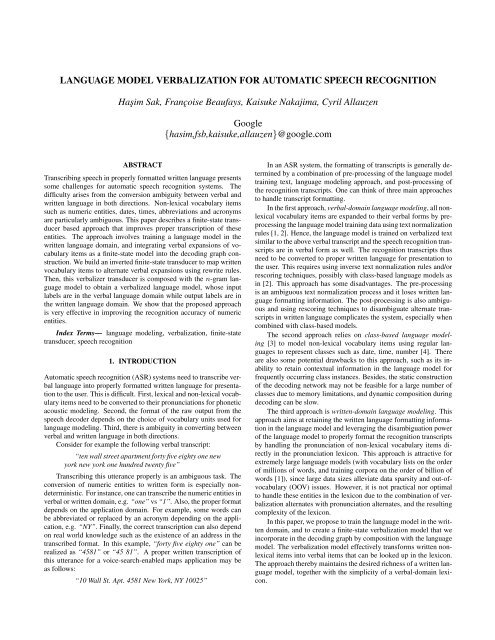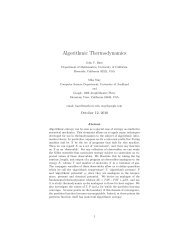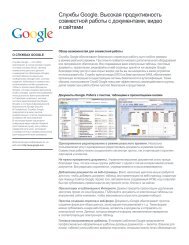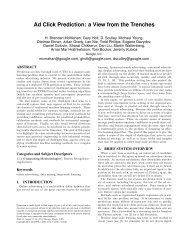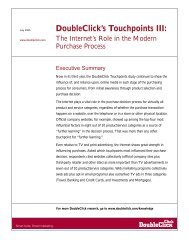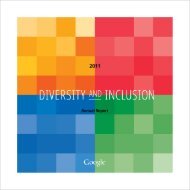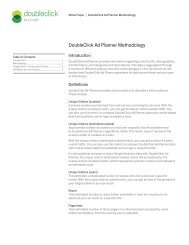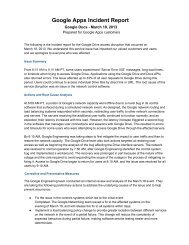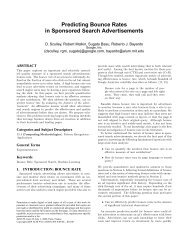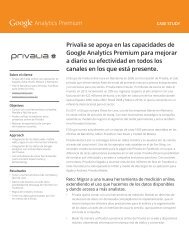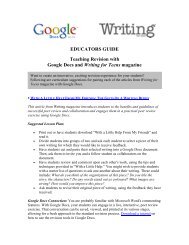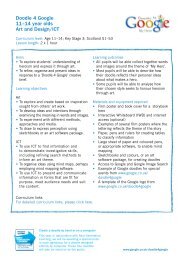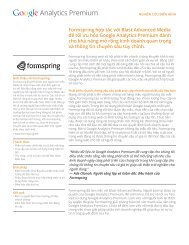Language Model Verbalization for Automatic Speech Recognition
Language Model Verbalization for Automatic Speech Recognition
Language Model Verbalization for Automatic Speech Recognition
You also want an ePaper? Increase the reach of your titles
YUMPU automatically turns print PDFs into web optimized ePapers that Google loves.
LANGUAGE MODEL VERBALIZATION FOR AUTOMATIC SPEECH RECOGNITION<br />
Haşim Sak, Françoise Beaufays, Kaisuke Nakajima, Cyril Allauzen<br />
Google<br />
{hasim,fsb,kaisuke,allauzen}@google.com<br />
ABSTRACT<br />
Transcribing speech in properly <strong>for</strong>matted written language presents<br />
some challenges <strong>for</strong> automatic speech recognition systems. The<br />
difficulty arises from the conversion ambiguity between verbal and<br />
written language in both directions. Non-lexical vocabulary items<br />
such as numeric entities, dates, times, abbreviations and acronyms<br />
are particularly ambiguous. This paper describes a finite-state transducer<br />
based approach that improves proper transcription of these<br />
entities. The approach involves training a language model in the<br />
written language domain, and integrating verbal expansions of vocabulary<br />
items as a finite-state model into the decoding graph construction.<br />
We build an inverted finite-state transducer to map written<br />
vocabulary items to alternate verbal expansions using rewrite rules.<br />
Then, this verbalizer transducer is composed with the n-gram language<br />
model to obtain a verbalized language model, whose input<br />
labels are in the verbal language domain while output labels are in<br />
the written language domain. We show that the proposed approach<br />
is very effective in improving the recognition accuracy of numeric<br />
entities.<br />
Index Terms— language modeling, verbalization, finite-state<br />
transducer, speech recognition<br />
1. INTRODUCTION<br />
<strong>Automatic</strong> speech recognition (ASR) systems need to transcribe verbal<br />
language into properly <strong>for</strong>matted written language <strong>for</strong> presentation<br />
to the user. This is difficult. First, lexical and non-lexical vocabulary<br />
items need to be converted to their pronunciations <strong>for</strong> phonetic<br />
acoustic modeling. Second, the <strong>for</strong>mat of the raw output from the<br />
speech decoder depends on the choice of vocabulary units used <strong>for</strong><br />
language modeling. Third, there is ambiguity in converting between<br />
verbal and written language in both directions.<br />
Consider <strong>for</strong> example the following verbal transcript:<br />
“ten wall street apartment <strong>for</strong>ty five eighty one new<br />
york new york one hundred twenty five”<br />
Transcribing this utterance properly is an ambiguous task. The<br />
conversion of numeric entities to written <strong>for</strong>m is especially nondeterministic.<br />
For instance, one can transcribe the numeric entities in<br />
verbal or written domain, e.g. “one” vs “1”. Also, the proper <strong>for</strong>mat<br />
depends on the application domain. For example, some words can<br />
be abbreviated or replaced by an acronym depending on the application,<br />
e.g. “NY”. Finally, the correct transcription can also depend<br />
on real world knowledge such as the existence of an address in the<br />
transcribed <strong>for</strong>mat. In this example, “<strong>for</strong>ty five eighty one” can be<br />
realized as “4581” or “45 81”. A proper written transcription of<br />
this utterance <strong>for</strong> a voice-search-enabled maps application may be<br />
as follows:<br />
“10 Wall St. Apt. 4581 New York, NY 10025”<br />
In an ASR system, the <strong>for</strong>matting of transcripts is generally determined<br />
by a combination of pre-processing of the language model<br />
training text, language modeling approach, and post-processing of<br />
the recognition transcripts. One can think of three main approaches<br />
to handle transcript <strong>for</strong>matting.<br />
In the first approach, verbal-domain language modeling, all nonlexical<br />
vocabulary items are expanded to their verbal <strong>for</strong>ms by preprocessing<br />
the language model training data using text normalization<br />
rules [1, 2]. Hence, the language model is trained on verbalized text<br />
similar to the above verbal transcript and the speech recognition transcripts<br />
are in verbal <strong>for</strong>m as well. The recognition transcripts thus<br />
need to be converted to proper written language <strong>for</strong> presentation to<br />
the user. This requires using inverse text normalization rules and/or<br />
rescoring techniques, possibly with class-based language models as<br />
in [2]. This approach has some disadvantages. The pre-processing<br />
is an ambiguous text normalization process and it loses written language<br />
<strong>for</strong>matting in<strong>for</strong>mation. The post-processing is also ambiguous<br />
and using rescoring techniques to disambiguate alternate transcripts<br />
in written language complicates the system, especially when<br />
combined with class-based models.<br />
The second approach relies on class-based language modeling<br />
[3] to model non-lexical vocabulary items using regular languages<br />
to represent classes such as date, time, number [4]. There<br />
are also some potential drawbacks to this approach, such as its inability<br />
to retain contextual in<strong>for</strong>mation in the language model <strong>for</strong><br />
frequently occurring class instances. Besides, the static construction<br />
of the decoding network may not be feasible <strong>for</strong> a large number of<br />
classes due to memory limitations, and dynamic composition during<br />
decoding can be slow.<br />
The third approach is written-domain language modeling. This<br />
approach aims at retaining the written language <strong>for</strong>matting in<strong>for</strong>mation<br />
in the language model and leveraging the disambiguation power<br />
of the language model to properly <strong>for</strong>mat the recognition transcripts<br />
by handling the pronunciation of non-lexical vocabulary items directly<br />
in the pronunciation lexicon. This approach is attractive <strong>for</strong><br />
extremely large language models (with vocabulary lists on the order<br />
of millions of words, and training corpora on the order of billion of<br />
words [1]), since large data sizes alleviate data sparsity and out-ofvocabulary<br />
(OOV) issues. However, it is not practical nor optimal<br />
to handle these entities in the lexicon due to the combination of verbalization<br />
alternates with pronunciation alternates, and the resulting<br />
complexity of the lexicon.<br />
In this paper, we propose to train the language model in the written<br />
domain, and to create a finite-state verbalization model that we<br />
incorporate in the decoding graph by composition with the language<br />
model. The verbalization model effectively trans<strong>for</strong>ms written nonlexical<br />
items into verbal items that can be looked up in the lexicon.<br />
The approach thereby maintains the desired richness of a written language<br />
model, together with the simplicity of a verbal-domain lexicon.
0<br />
1:o<br />
1:t<br />
N:n<br />
S:s<br />
3<br />
1<br />
2<br />
0:n<br />
4<br />
Y:e<br />
t:t<br />
t:a<br />
8<br />
0:e<br />
5<br />
6<br />
ϵ:e<br />
9<br />
ϵ:w<br />
.:r<br />
7<br />
13<br />
10<br />
11<br />
.:i<br />
ϵ:[space]<br />
ϵ:[space]<br />
ϵ:e<br />
12<br />
Fig. 1. Finite-state transducer <strong>for</strong> the sample rewrite grammar rule.<br />
2. LANGUAGE MODEL VERBALIZATION<br />
Weighted finite-state transducers (WFSTs) are widely used to represent<br />
all the components of a speech recognition system [5]. This<br />
representation comes together with a composition algorithm that<br />
efficiently combines all the components into a single finite-state decoding<br />
network. More specifically, in a finite-state transducer based<br />
ASR system, a decoding network D is typically constructed by<br />
composing the following finite-state models: a context-dependency<br />
model C mapping context-dependent phones to context-independent<br />
phones, a pronunciation lexicon L mapping context-independent<br />
phone sequences to words, and an n-gram language model G assigning<br />
probabilities to word sequences. In the WFST framework,<br />
this is expressed as D = C ◦ L ◦ G, where ◦ is the composition<br />
operator. In this setup, the speech decoder handles decoding<br />
over the Hidden Markov <strong>Model</strong> (HMM) states corresponding to<br />
context-dependent phones. An alternative proposed in [6] is to<br />
also incorporate a Hidden Markov <strong>Model</strong> H mapping HMM state<br />
sequences to context-dependent phones into the decoding network<br />
construction, which can be expressed as D = H ◦ C ◦ L ◦ G. In<br />
this work, we chose the first setup. Our implementation relies on the<br />
OpenFst weighted finite-state transducer library [7].<br />
2.1. Approach<br />
In this paper, we propose to incorporate a verbal expansion of vocabulary<br />
items in the construction of the decoding network. To this end,<br />
we construct a finite-state verbalizer transducer V that maps verbal<br />
expansion of word sequences to vocabulary items. With this model,<br />
the decoding network can be expressed as D = C ◦ L ◦ V ◦ G. We<br />
use grammars to expand non-lexical items such as numeric entities.<br />
Such grammars rely on regular expressions and context-dependent<br />
rewrite rules, and are commonly used <strong>for</strong> text processing and verbal<br />
expansion <strong>for</strong> text-to-speech and speech recognition. They can be<br />
efficiently compiled into finite-state transducers [8, 9].<br />
A sample rewrite grammar rule is given below <strong>for</strong> a small set<br />
of vocabulary items. (The rewrite rules <strong>for</strong> numeric entities can be<br />
expressed efficiently in compact <strong>for</strong>m due to the regular language<br />
nature of these entities, rather than explicitly listing them as in the<br />
example.)<br />
rule = (“10” : “ten”) | (“10” : “one zero”) |<br />
(“NY” : “new york”) | (“St.” : “street”) | (“St.” :<br />
“saint”) ;<br />
This sample rule can be efficiently compiled into a finite-state<br />
transducer representation as shown in Figure 1 using a rule compiler<br />
[9]. We defined multiple grammar rules to verbalize various<br />
17<br />
14<br />
15<br />
ϵ:n<br />
ϵ:z<br />
ϵ:y<br />
ϵ:e<br />
19<br />
ϵ:n<br />
18<br />
16<br />
ϵ:e<br />
ϵ:o<br />
21<br />
20<br />
ϵ:r<br />
ϵ:r<br />
ϵ:t<br />
23<br />
22<br />
ϵ:o<br />
ϵ:k<br />
24<br />
V ← vocabulary of language model<br />
R ← set of finite-state transducers <strong>for</strong> rewrite grammar rules<br />
<strong>for</strong> all v ∈ V do<br />
W ← ∅<br />
<strong>for</strong> all r ∈ R do<br />
w ← rewrite(v, r)<br />
if w is not empty string then<br />
insert w into W<br />
end if<br />
end <strong>for</strong><br />
if W is ∅ then<br />
W ← v<br />
end if<br />
<strong>for</strong> all w ∈ W do<br />
add a path w → v to V FST<br />
end <strong>for</strong><br />
end <strong>for</strong><br />
V F ST ← closure(determinize(V FST))<br />
Fig. 2. The verbalizer FST construction algorithm.<br />
ten:10<br />
ten:ten<br />
york:York<br />
one:one<br />
zero:zero<br />
0 street:St.<br />
3<br />
saint:St.<br />
one:10<br />
new:NY<br />
new:New<br />
new:new<br />
2<br />
1<br />
zero:ϵ<br />
york:ϵ<br />
Fig. 3. Example finite-state transducer V <strong>for</strong> a simple nondeterminized<br />
non-closed verbalizer model.<br />
classes of vocabulary items and all these rules were compiled into a<br />
set of finite-state transducers.<br />
2.2. Verbalizer <strong>Model</strong> Construction<br />
We use a simple algorithm to construct the finite-state transducer <strong>for</strong><br />
the verbalizer as shown in Figure 2. The algorithm takes as input the<br />
vocabulary of the language model, the set of finite-state transducers<br />
<strong>for</strong> the compiled rewrite grammar rules. It enumerates all the vocabulary<br />
items and tries to rewrite each vocabulary item using each<br />
rewrite grammar rule transducer, and accumulates these verbal expansions<br />
in a set. If there is no rule that applies to a vocabulary item,<br />
the item itself is inserted in the set of verbal expansions. This is generally<br />
true <strong>for</strong> lexical vocabulary items, <strong>for</strong> which the lexicon can<br />
directly produce pronunciation alternatives. To construct the verbalizer<br />
transducer using all possible verbal expansions <strong>for</strong> each vocabulary<br />
item, we simply add paths from the start state to the final state<br />
of the transducer with each verbal expansion <strong>for</strong> a vocabulary item<br />
on the input label and that vocabulary item on the output label.<br />
A simple finite-state transducer <strong>for</strong> the verbalizer model is<br />
shown in Figure 3. The input labels are in verbal domain and the
output labels are in the written domain of the language model.<br />
Please note that verbal expansions of vocabulary items are not<br />
context-dependent. We need a parallel corpus of sentences in written<br />
and verbal language to learn a context-dependent verbalization<br />
model. It also requires model smoothing to generalize verbalization<br />
over unseen instances especially <strong>for</strong> numeric entities. The verbalizer<br />
can also be used to normalize capitalization <strong>for</strong> the lexicon if<br />
capitalization is retained in the language model. Finally, it is also<br />
possible to assign weights to the rewrite rules and in the verbalizer<br />
model to discriminate between verbalization alternates. As seen in<br />
this example, the verbalizer model is non-deterministic in both input<br />
and output labels.<br />
We use the generalized composition algorithm by Allauzen et<br />
al. [10] to compose the verbalizer transducer V with the language<br />
model G. This algorithm allows efficient composition by avoiding<br />
the creation of useless output-epsilon paths while also optimizing<br />
the composed model by pushing <strong>for</strong>ward labels and weights <strong>for</strong> runtime<br />
efficiency. The resulting verbalized language model can be used<br />
with dynamic, runtime, composition in the decoder or it can be statically<br />
composed with the context-dependent lexicon to build a static<br />
decoding network.<br />
3. EVALUATION<br />
We applied the language model verbalization approach to the modeling<br />
of numerical entities in Google’s French speech recognition<br />
system. This system used to rely on the written-domain language<br />
modeling approach described in Section 1. We chose this specific application<br />
after noticing that a large fraction of the French recognition<br />
traffic was related to Maps entities, and that the written-domain approach<br />
was causing a lot of <strong>for</strong>matting errors on such entries. Times,<br />
dates, and other numerical entities were also affected, and improved<br />
as a result of this work.<br />
In the subsections below, we first describe the number error rate<br />
metric that we used to evaluate recognition accuracy <strong>for</strong> numeric<br />
entities. Then, we discuss the language modeling data used in the<br />
system. Finally, we give experimental results <strong>for</strong> various systems.<br />
3.1. Evaluation Metric<br />
We measure the recognition accuracy of numeric entities such as<br />
numbers, times, and dates by evaluating a metric similar to the word<br />
error rate (WER), but specific to numeric entities. We call this metric<br />
the number error rate (NER). To compute the NER, we first align<br />
the recognition hypothesis with the reference transcription. We then<br />
assume that any word containing a digit is a numeric entity, and we<br />
define the NER as follows:<br />
ND + NI + NS<br />
NER =<br />
NN<br />
where ND, NI, NS are the numbers of numeric deletions, insertions,<br />
and substitutions, respectively. NN is the total number of numeric<br />
entities in the reference.<br />
3.2. Baseline System<br />
The baseline speech recognition engine is a standard large-vocabulary<br />
recognizer, with PLP features and LDA. The acoustic models use<br />
decision trees to train GMM-based triphone HMMs. The acoustic<br />
models are trained with maximum likelihood, followed by boosted<br />
MMI [11].<br />
WER (%)<br />
40<br />
38<br />
36<br />
34<br />
32<br />
30<br />
28<br />
sup<br />
sup + verbalized<br />
sup + unsup<br />
sup + unsup + verbalized<br />
sup + unsup (redecoded)<br />
sup + unsup (redecoded) + verbalized<br />
0.4 0.6 0.8 1.0 1.2 1.4 1.6<br />
Normalized real-time factor (CPU time / audio time)<br />
Fig. 4. Word error rate at various normalized real-time factors.<br />
The language model is a standard 5-gram language model<br />
trained from web documents and anonymized Google web search<br />
queries. Anonymized speech logs are added to the training corpora<br />
in some of the experiments below. In all cases, the language modeling<br />
pipeline trains a model <strong>for</strong> each data source, and then linearly<br />
interpolates the individual models using a development set to optimize<br />
the interpolation weights. The final model is entropy-pruned<br />
to a size that fits our production resource targets.<br />
3.3. Experimental Results<br />
We used a set of rewrite grammar rules to expand numeric entities<br />
in French. These rules were used to build a verbalizer transducer<br />
that can generate verbal expansions <strong>for</strong> digit sequences, dates, times,<br />
postal codes, decimal numbers, cardinal numbers, and ordinal numbers.<br />
The resulting recognizer was evaluated on an anonymized and<br />
randomly selected test set that matches our current speech traffic<br />
patterns in France. The test set contains 22K utterances and 85K<br />
words, of which 2K are numeric entities. The set was transcribed in<br />
written language, i.e. the transcribers were instructed to type “23” if<br />
they heard “vingt-trois”.<br />
We evaluate three different systems. In the first system, (supervised),<br />
we only used typed text data from web documents and<br />
search queries to train the language model. In the second system,<br />
(supervised + unsupervised), we added anonymized speech recognition<br />
logs to the language model training data. These logs consist<br />
of recognition results from the then-deployed system, untranscribed,<br />
but filtered by recognition confidence. In the third system, (supervised<br />
+ unsupervised (redecoded)), we redecoded the speech logs<br />
using the verbalized system from the second system to generate better<br />
transcripts. The aim of redecoding is to fix <strong>for</strong>matting errors on<br />
numeric entities caused by the original production system.<br />
We report the per<strong>for</strong>mance improvement brought by the verbalizer<br />
on these three systems.<br />
Figure 4 shows the word error rate of the evaluated systems <strong>for</strong><br />
various real-time factors obtained by changing the beam width of<br />
the decoder. This experiment clearly shows that using the unsupervised<br />
data <strong>for</strong> language modeling improves the speech recognition
NER (%)<br />
65<br />
60<br />
55<br />
50<br />
45<br />
sup<br />
sup + verbalized<br />
sup + unsup<br />
sup + unsup + verbalized<br />
sup + unsup (redecoded)<br />
sup + unsup (redecoded) + verbalized<br />
to written-domain word sequences. This composition can be seen<br />
as verbalizing the language model by converting the written-domain<br />
language model into a transducer whose input labels are verbal expansions<br />
of the output labels in the grammar. The approach allows<br />
multiple ways of verbalizing a vocabulary item, and provides the<br />
flexibility to insert intra-word silences where desired. The verbalizer<br />
simplifies the lexicon, since the verbalization is separated from<br />
the pronunciation modeling, and the lexicon only has to deal with<br />
the verbal word <strong>for</strong>ms.<br />
This approach improved the recognition of numerical entities in<br />
French by almost 30% over the baseline production system, while<br />
maintaining its latency characteristics.<br />
40<br />
35<br />
0.4 0.6 0.8 1.0 1.2 1.4 1.6<br />
Normalized real-time factor (CPU time / audio time)<br />
Fig. 5. Number error rate at various normalized real-time factors.<br />
accuracy significantly. For instance, the accuracy improves by about<br />
12% relative at the normalized real-time recognition speed. We can<br />
also see that language model verbalization and redecoding the unsupervised<br />
data with the verbalized system does not have a significant<br />
effect on the WER. This is expected since these experiments concentrate<br />
on improving the numeric entity recognition, and the numeric<br />
entities constitute a small percentage of the test set. For example,<br />
if we removed all the numeric entities from the speech recognition<br />
vocabulary, the WER would only degrade about 2%.<br />
The impact of verbalization is obvious by tracking the number<br />
error rate, as in Figure 5. This figure clearly shows that language<br />
model verbalization significantly improves the recognition accuracy<br />
of numeric entities <strong>for</strong> all the systems. For instance, the best system<br />
(supervised + unsupervised (redecoded) + verbalized) improves the<br />
NER by about 27% over the baseline system (supervised + unsupervised)<br />
at the normalized real-time recognition speed. It is also<br />
interesting to observe that while using unsupervised data improves<br />
the WER, it degrades the NER significantly. This is clearly due to a<br />
high number of recognition/<strong>for</strong>matting errors in numeric entities in<br />
the baseline system. This shows that using unsupervised data <strong>for</strong> language<br />
modeling may pollute the training data with incorrectly transcribed<br />
entities. This data can poison the system to generate more<br />
recognition errors <strong>for</strong> these types of entities even though the WER<br />
of the system improves. Redecoding was indispensable in this case.<br />
4. CONCLUSION<br />
We described a transducer-based method to handle non-lexical entities<br />
in a speech recognition system. Using a finite-state model to<br />
integrate the verbalization into the decoder network provides some<br />
advantages. By facilitating the training of the language model in<br />
the written domain, it prevents the error-prone conversion of written<br />
text to the verbal domain with text-normalization rules. The writtendomain<br />
language model provides disambiguation power that simple<br />
text-normalization rules can not include.<br />
We showed that the language model can be efficiently verbalized<br />
by simply composing it with the verbalizer transducer. The resulting<br />
verbalized language model converts verbal word sequences<br />
5. ACKNOWLEDGEMENT<br />
We would like to thank Richard Sproat and Martin Jansche <strong>for</strong> their<br />
contributions to rewrite grammar library and rules, and Eugene Weinstein<br />
<strong>for</strong> his help on integration to the infrastructure.<br />
6. REFERENCES<br />
[1] C. Chelba, J. Schalkwyk, T. Brants, V. Ha, B. Harb, W. Neveitt,<br />
C. Parada, and P. Xu, “Query language modeling <strong>for</strong> voice<br />
search,” in Spoken <strong>Language</strong> Technology Workshop (SLT),<br />
2010 IEEE, dec. 2010, pp. 127 –132.<br />
[2] Maria Shugrina, “Formatting time-aligned ASR transcripts <strong>for</strong><br />
readability,” in Human <strong>Language</strong> Technologies: The 2010 Annual<br />
Conference of the North American Chapter of the Association<br />
<strong>for</strong> Computational Linguistics, Stroudsburg, PA, USA,<br />
2010, HLT ’10, pp. 198–206, Association <strong>for</strong> Computational<br />
Linguistics.<br />
[3] Peter F. Brown, Peter V. deSouza, Robert L. Mercer, Vincent<br />
J. Della Pietra, and Jenifer C. Lai, “Class-based n-gram models<br />
of natural language,” Computational Linguistics, vol. 18, no.<br />
4, pp. 467–479, Dec. 1992.<br />
[4] Cyril Allauzen, Mehryar Mohri, and Brian Roark, “Generalized<br />
algorithms <strong>for</strong> constructing statistical language models,”<br />
in Proceedings of the 41st Annual Meeting on Association <strong>for</strong><br />
Computational Linguistics - Volume 1, Stroudsburg, PA, USA,<br />
2003, ACL ’03, pp. 40–47, Association <strong>for</strong> Computational Linguistics.<br />
[5] Mehryar Mohri, Michael Riley, Don Hindle, Andrej Ljolje, and<br />
Fernando Pereira, “Full expansion of context-dependent networks<br />
in large vocabulary speech recognition,” in Proceedings<br />
of ICASSP 98, 1998, pp. 665–668.<br />
[6] Mehryar Mohri and Michael Riley, “Integrated contextdependent<br />
networks in very large vocabulary speech recognition,”<br />
in Proceedings of the 6th European Conference<br />
on <strong>Speech</strong> Communication and Technology (Eurospeech ’99,<br />
1999, pp. 811–814.<br />
[7] Cyril Allauzen, Michael Riley, Johan Schalkwyk, Wojciech<br />
Skut, and Mehryar Mohri, “Openfst: a general and efficient<br />
weighted finite-state transducer library,” in Proceedings of the<br />
12th international conference on Implementation and application<br />
of automata, Berlin, Heidelberg, 2007, CIAA’07, pp. 11–<br />
23, Springer-Verlag.<br />
[8] Mehryar Mohri and Richard Sproat, “An efficient compiler<br />
<strong>for</strong> weighted rewrite rules,” in 34th Annual Meeting of The<br />
Association <strong>for</strong> Computational Linguistics, 1996, pp. 231–238.
[9] Brian Roark, Richard Sproat, Cyril Allauzen, Michael Riley,<br />
Jeffrey Sorensen, and Terry Tai, “The opengrm open-source<br />
finite-state grammar software libraries,” in Proceedings of the<br />
ACL 2012 System Demonstrations, Jeju Island, Korea, July<br />
2012, pp. 61–66, Association <strong>for</strong> Computational Linguistics.<br />
[10] Cyril Allauzen, Michael Riley, and Johan Schalkwyk, “A generalized<br />
composition algorithm <strong>for</strong> weighted finite-state transducers,”<br />
in Proceedings of Interspeech, 2009, pp. 1203–1206.<br />
[11] D. Povey, D. Kanevsky, B. Kingsbury, B. Ramabhadran,<br />
G. Saon, and K. Visweswariah, “Boosted MMI <strong>for</strong> model and<br />
feature-space discriminative training,” in Acoustics, <strong>Speech</strong><br />
and Signal Processing, 2008. ICASSP 2008. IEEE International<br />
Conference on, 2008, pp. 4057 –4060.


